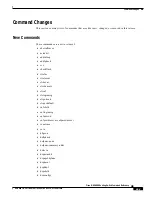
1-2
Cisco MGX 8850 Routing Switch Command Reference
Release 2.0, Part Number 78-10467-04 Rev C0, October 2001
Chapter 1
Command Line Interface Overview
Command Line Prompt
Command Line Prompt
The format of the CLI prompt is:
name.slot number.card type.card state >
where:
•
name is the name of the node (“Unknown” until a you assign name with the cnfname command).
•
slot number is the slot of the front card.
•
card type identifies the Processor Switching Module 45 (PXM45) or a service module type, such as
the AXSM.
•
card state is “i” for initialized, “a” for active, or “s” for standby. For many commands, a card must
be active before the command can execute, so each command description has an Attributes section
that identifies the states in which the command can execute.
–
A card in the initialized state (i) is still loading application modules.
–
A card in the active (a) state either is fully configured and ready to carry out its function or is
already performing its function with live traffic.
–
Typically, a card goes into the standby (s) state when it first powers up and boots or when you
execute a command that puts it in the standby state. For example, the commands for a graceful
upgrade of firmware on a pair of PXM45s puts the active card in the standby state and the
standby card in the active state (see loadrev description for details).
An example of a CLI prompt is:
MGX8850.7.PXM45.a >
The preceding prompt shows that the
•
Name of the node is “excel.”
•
Slot number is 7.
•
Card type is PXM45.
•
Card state is active.
Command Syntax
This section contains the following syntax topics:
•
Notation
•
Position-dependent parameters
•
Keyword-driven parameters
•
Logical port format
•
Command entry
















































